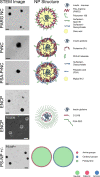Barriers to the Intestinal Absorption of Four Insulin-Loaded Arginine-Rich Nanoparticles in Human and Rat
- PMID: 35998570
- PMCID: PMC9527806
- DOI: 10.1021/acsnano.2c04330
Barriers to the Intestinal Absorption of Four Insulin-Loaded Arginine-Rich Nanoparticles in Human and Rat
Abstract
Peptide drugs and biologics provide opportunities for treatments of many diseases. However, due to their poor stability and permeability in the gastrointestinal tract, the oral bioavailability of peptide drugs is negligible. Nanoparticle formulations have been proposed to circumvent these hurdles, but systemic exposure of orally administered peptide drugs has remained elusive. In this study, we investigated the absorption mechanisms of four insulin-loaded arginine-rich nanoparticles displaying differing composition and surface characteristics, developed within the pan-European consortium TRANS-INT. The transport mechanisms and major barriers to nanoparticle permeability were investigated in freshly isolated human jejunal tissue. Cytokine release profiles and standard toxicity markers indicated that the nanoparticles were nontoxic. Three out of four nanoparticles displayed pronounced binding to the mucus layer and did not reach the epithelium. One nanoparticle composed of a mucus inert shell and cell-penetrating octarginine (ENCP), showed significant uptake by the intestinal epithelium corresponding to 28 ± 9% of the administered nanoparticle dose, as determined by super-resolution microscopy. Only a small fraction of nanoparticles taken up by epithelia went on to be transcytosed via a dynamin-dependent process. In situ studies in intact rat jejunal loops confirmed the results from human tissue regarding mucus binding, epithelial uptake, and negligible insulin bioavailability. In conclusion, while none of the four arginine-rich nanoparticles supported systemic insulin delivery, ENCP displayed a consistently high uptake along the intestinal villi. It is proposed that ENCP should be further investigated for local delivery of therapeutics to the intestinal mucosa.
Keywords: human; insulin; jejunum; nanoparticle; oral peptide delivery.
Conflict of interest statement
The authors declare no competing financial interest.
Figures







Similar articles
-
Virus-Mimicking Mesoporous Silica Nanoparticles with an Electrically Neutral and Hydrophilic Surface to Improve the Oral Absorption of Insulin by Breaking Through Dual Barriers of the Mucus Layer and the Intestinal Epithelium.ACS Appl Mater Interfaces. 2021 Apr 21;13(15):18077-18088. doi: 10.1021/acsami.1c00580. Epub 2021 Apr 8. ACS Appl Mater Interfaces. 2021. PMID: 33830730
-
Overcoming the diffusion barrier of mucus and absorption barrier of epithelium by self-assembled nanoparticles for oral delivery of insulin.ACS Nano. 2015 Mar 24;9(3):2345-56. doi: 10.1021/acsnano.5b00028. Epub 2015 Feb 10. ACS Nano. 2015. PMID: 25658958
-
Enhanced oral absorption and anticancer efficacy of cabazitaxel by overcoming intestinal mucus and epithelium barriers using surface polyethylene oxide (PEO) decorated positively charged polymer-lipid hybrid nanoparticles.J Control Release. 2018 Jan 10;269:423-438. doi: 10.1016/j.jconrel.2017.11.015. Epub 2017 Nov 11. J Control Release. 2018. PMID: 29133120
-
Mechanisms of Nanoparticle Transport across Intestinal Tissue: An Oral Delivery Perspective.ACS Nano. 2023 Jul 25;17(14):13044-13061. doi: 10.1021/acsnano.3c02403. Epub 2023 Jul 6. ACS Nano. 2023. PMID: 37410891 Review.
-
Intestinal nanoparticle delivery and cellular response: a review of the bidirectional nanoparticle-cell interplay in mucosa based on physiochemical properties.J Nanobiotechnology. 2024 Nov 1;22(1):669. doi: 10.1186/s12951-024-02930-6. J Nanobiotechnology. 2024. PMID: 39487532 Free PMC article. Review.
Cited by
-
Application of Nanoparticles: Diagnosis, Therapeutics, and Delivery of Insulin/Anti-Diabetic Drugs to Enhance the Therapeutic Efficacy of Diabetes Mellitus.Life (Basel). 2022 Dec 11;12(12):2078. doi: 10.3390/life12122078. Life (Basel). 2022. PMID: 36556443 Free PMC article. Review.
-
Intestinal epithelium penetration of liraglutide via cholic acid pre-complexation and zein/rhamnolipids nanocomposite delivery.J Nanobiotechnology. 2023 Jan 16;21(1):16. doi: 10.1186/s12951-022-01743-9. J Nanobiotechnology. 2023. PMID: 36647125 Free PMC article.
-
Muco-Adhesive and Muco-Penetrative Formulations for the Oral Delivery of Insulin.ACS Omega. 2024 May 29;9(23):24121-24141. doi: 10.1021/acsomega.3c10305. eCollection 2024 Jun 11. ACS Omega. 2024. PMID: 38882129 Free PMC article. Review.
-
A Comprehensive Analysis of Biopharmaceutical Products Listed in the FDA's Purple Book.AAPS PharmSciTech. 2024 Apr 18;25(5):88. doi: 10.1208/s12249-024-02802-0. AAPS PharmSciTech. 2024. PMID: 38637407 Review.

